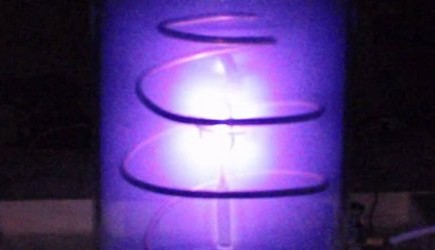"I Built Myself A Nuclear Fusion Reactor When I Was 16"
March 20, 2014
on
on

In 2011 a 16-year-old high school student from Ohio named William Jack built himself a nuclear fusion reactor in his basement. Since then he has gone on to continue pursuits in the development of science and technologies as an undergrad at MIT.
I recently interviewed the multi-talented and (intimidatingly) clever William Jack. We discussed his work on the inertial electrostatic confinement (IEC) fusion reactors that he had built, engineering and hackerspaces.
ADG: Can you explain a little bit about who you are and what you do? What do people find interesting about your work?
WJ: I'm an 18 year old science and engineering student at MIT. I'm interested in physics, entrepreneurship, engineering, technology in general, and I guess I'm some one who loves to tinker around.
ADG: And you built a nuclear fusion reactor in your basement.
WJ: [laughs] Yeah, that too.
ADG: What was your first engineering project?
WJ: First ever engineering project? Hmm. I really liked playing with legos as a kid. [laughs]
I always liked doing engineering projects, I remember in 6th grade science class we were doing a catapult project... my teacher didn't specify a size requirement, so I went all-out and made a 9-foot tall [2.7m] catapult out of wood.
ADG: I'm sure your teacher amended the syllabus after that.
WJ: I shot a marshmallow over 240 feet [73m] through the air. I think that was a good experience for my first engineering project.
ADG: What piqued your interest in science and engineering?
WJ: I became really interested in particle physics in grade school... there was a lot of progress with the [Large] Hadron Collider at CERN, which was very inspiring.
I wanted to build a reactor. I did some research online and found out it could be done. It wasn't impossible.
ADG: Can you briefly explain inertial electrostatic confinement fusion?
 WJ: Nuclear fusion is basically when you collide two light atoms and they combine into a heavier one. The inertial electrostatic confinement fusion (IEC) reactor is a device that carries out nuclear fusion by using electrostatic fields to accelerate and confine deuterium ions to central point in a vacuum chamber, occasionally some of the deuterium ions in the plasma will collide, and fuse together into helium-3 and a high energy neutron, or hydrogen-3 and a proton.
WJ: Nuclear fusion is basically when you collide two light atoms and they combine into a heavier one. The inertial electrostatic confinement fusion (IEC) reactor is a device that carries out nuclear fusion by using electrostatic fields to accelerate and confine deuterium ions to central point in a vacuum chamber, occasionally some of the deuterium ions in the plasma will collide, and fuse together into helium-3 and a high energy neutron, or hydrogen-3 and a proton.
Deuterium is a special kind of hydrogen with an extra neutron. Regular hydrogen has a single proton and no neutron in the nucleus.
A vacuum chamber filled with deuterium gas is brought to an extremely low pressure, about 5-10 millitorr [1 millitorr is 1/760000 of atmospheric pressure]. Inside the vacuum chamber, a spherical grid of wires in the center of the chamber is brought to a very low negative potential, typically ranging from -20kV to more than -100kV. The strong electric field produced from this ionizes the deuterium gas. The positively charged ions of deuterium are then accelerated towards the negatively charged grid to a great speed, where some of them collide together and fuse into either He-3, emitting a neutron, or H-3, emitting a proton. The neutrons can be detected, and are often used as key proof of fusion.
ADG: Does it have any commercial applications?
WJ: I've come up with some ideas for how IEC fusion reactors could be integrated into medical imaging devices that expose patients to very little radiation, are inexpensive, and accurate. I hope that devices like these could make routine preventative imaging a more accessible reality.
ADG: What advice would you have for anyone interested in learning about IEC fusion? Are there any resources you would recommend?
WJ: Just learning about it? The internet is a phenomenal resource.
ADG: Are there any precautions to take?
WJ: Certainly. Radiation is not much of a concern, other than some X-rays that are generated that are easily stopped. It's important to find people who are experienced with high voltage technology to help with your projects.
ADG: Do you have any advice for hackerspaces on how to begin some projects like the ones you've been working on? How to get involved?
WJ: Try to find a supportive hackerspace and try to get involved in the community... try to get authorization on a big project like this. Make sure to talk to people about the potential risks and hazards, have a plan in mind about how to manage that, and how to keep that from being a problem.
Hackerspaces are a great place for people to learn new things, and exchange knowledge. They're like a modern day French salon in a way, where people exchange ideas and talk to each other. Hackerspaces are awesome!
For more information about Will Jack's reactor, check out his keynote speech at the EHSM 2012.
I recently interviewed the multi-talented and (intimidatingly) clever William Jack. We discussed his work on the inertial electrostatic confinement (IEC) fusion reactors that he had built, engineering and hackerspaces.
ADG: Can you explain a little bit about who you are and what you do? What do people find interesting about your work?
WJ: I'm an 18 year old science and engineering student at MIT. I'm interested in physics, entrepreneurship, engineering, technology in general, and I guess I'm some one who loves to tinker around.
ADG: And you built a nuclear fusion reactor in your basement.
WJ: [laughs] Yeah, that too.
ADG: What was your first engineering project?
WJ: First ever engineering project? Hmm. I really liked playing with legos as a kid. [laughs]
I always liked doing engineering projects, I remember in 6th grade science class we were doing a catapult project... my teacher didn't specify a size requirement, so I went all-out and made a 9-foot tall [2.7m] catapult out of wood.
ADG: I'm sure your teacher amended the syllabus after that.
WJ: I shot a marshmallow over 240 feet [73m] through the air. I think that was a good experience for my first engineering project.
ADG: What piqued your interest in science and engineering?
WJ: I became really interested in particle physics in grade school... there was a lot of progress with the [Large] Hadron Collider at CERN, which was very inspiring.
I wanted to build a reactor. I did some research online and found out it could be done. It wasn't impossible.
ADG: Can you briefly explain inertial electrostatic confinement fusion?
 WJ: Nuclear fusion is basically when you collide two light atoms and they combine into a heavier one. The inertial electrostatic confinement fusion (IEC) reactor is a device that carries out nuclear fusion by using electrostatic fields to accelerate and confine deuterium ions to central point in a vacuum chamber, occasionally some of the deuterium ions in the plasma will collide, and fuse together into helium-3 and a high energy neutron, or hydrogen-3 and a proton.
WJ: Nuclear fusion is basically when you collide two light atoms and they combine into a heavier one. The inertial electrostatic confinement fusion (IEC) reactor is a device that carries out nuclear fusion by using electrostatic fields to accelerate and confine deuterium ions to central point in a vacuum chamber, occasionally some of the deuterium ions in the plasma will collide, and fuse together into helium-3 and a high energy neutron, or hydrogen-3 and a proton.Deuterium is a special kind of hydrogen with an extra neutron. Regular hydrogen has a single proton and no neutron in the nucleus.
A vacuum chamber filled with deuterium gas is brought to an extremely low pressure, about 5-10 millitorr [1 millitorr is 1/760000 of atmospheric pressure]. Inside the vacuum chamber, a spherical grid of wires in the center of the chamber is brought to a very low negative potential, typically ranging from -20kV to more than -100kV. The strong electric field produced from this ionizes the deuterium gas. The positively charged ions of deuterium are then accelerated towards the negatively charged grid to a great speed, where some of them collide together and fuse into either He-3, emitting a neutron, or H-3, emitting a proton. The neutrons can be detected, and are often used as key proof of fusion.
ADG: Does it have any commercial applications?
WJ: I've come up with some ideas for how IEC fusion reactors could be integrated into medical imaging devices that expose patients to very little radiation, are inexpensive, and accurate. I hope that devices like these could make routine preventative imaging a more accessible reality.
ADG: What advice would you have for anyone interested in learning about IEC fusion? Are there any resources you would recommend?
WJ: Just learning about it? The internet is a phenomenal resource.
ADG: Are there any precautions to take?
WJ: Certainly. Radiation is not much of a concern, other than some X-rays that are generated that are easily stopped. It's important to find people who are experienced with high voltage technology to help with your projects.
ADG: Do you have any advice for hackerspaces on how to begin some projects like the ones you've been working on? How to get involved?
WJ: Try to find a supportive hackerspace and try to get involved in the community... try to get authorization on a big project like this. Make sure to talk to people about the potential risks and hazards, have a plan in mind about how to manage that, and how to keep that from being a problem.
Hackerspaces are a great place for people to learn new things, and exchange knowledge. They're like a modern day French salon in a way, where people exchange ideas and talk to each other. Hackerspaces are awesome!
For more information about Will Jack's reactor, check out his keynote speech at the EHSM 2012.
Alison Dorantes-Garcia has done a series of interviews with speakers of EHSM (Exceptional Hardware Software Meeting) 2012. The conference explores the outer limits of open source hardware and software. The second edition of EHSM will take place in Hamburg, Germany June 27-29, 2014. The interviews will be published weekly on TTF
Read full article
Hide full article


Discussion (0 comments)